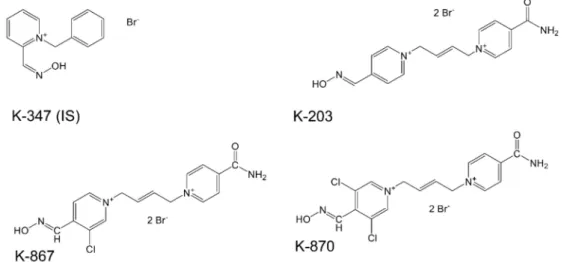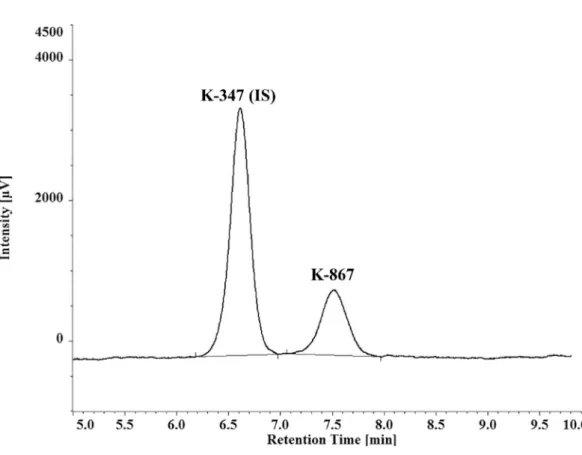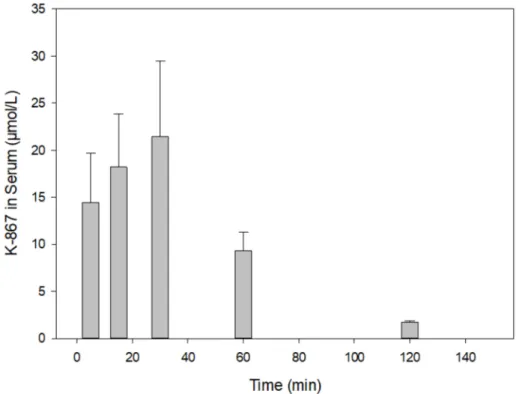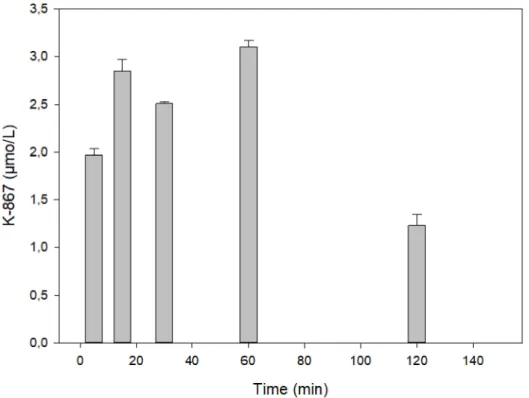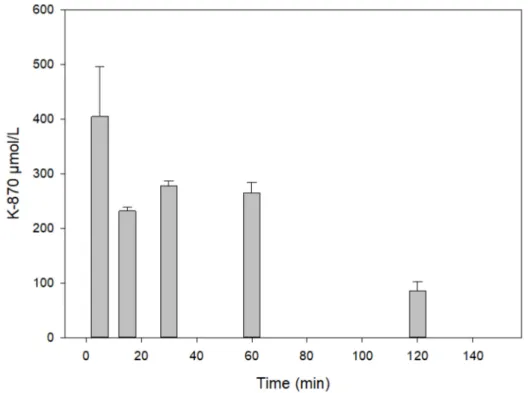Article
Pharmacokinetics of Two Chlorine-Substituted
Bis-Pyridinium Mono-Aldoximes with Regenerating E ff ect on Butyrylcholinesterase
Huba Kalász1,2,*, Zoltán Szimrók1, Gellért Karvaly3, Jennifer Adeghate1,4and Kornélia Tekes5
1 Department of Pharmacology and Pharmacotherapy, Semmelweis University, Nagyvárad tér 4, 1089 Budapest, Hungary; szimrokz@gmail.com (Z.S.); jen.adeghate@gmail.com (J.A.)
2 Kalász Teaching and Research Co., Gvadányi utca 44-46, 1144 Budapest, Hungary
3 Department of Laboratory Medicine, Semmelweis University, Nagyvárad tér 4, 1089 Budapest, Hungary;
karvaly.gellert_balazs@med.semmelweis-univ.hu
4 Department of Ophthalmology, University of Pittsburgh School of Medicine, Suite 820, Eye & Ear Building, 203 Lothrop Street, Pittsburgh, PA 15213, USA
5 Department of Pharmacodynamics, Semmelweis University, Nagyvárad tér 4, 1089 Budapest, Hungary;
drtekes@gmail.com
* Correspondence: drkalasz@gmail.com Academic Editor: Pascal Houzé
Received: 23 December 2019; Accepted: 9 March 2020; Published: 10 March 2020
Abstract: Our aim was to find chlorine-substituted antidotes against organophosphate poisoning and compare their pharmacokinetics to their parent compound, K-203. White male Wistar rats were intramuscularly injected with K-203, K-867 or K-870. Serum, brain, kidneys, liver, lung, eyes, and testes tissues were taken after 5, 15, 30, 60, and 120 min and analyzed using reversed-phase high-performance liquid chromatography. K-203, K-867, or K-870 was present in every tissue that was analyzed, including the serum, the eyes, testes, liver, kidneys, lungs, and the brain. The serum levels of K-867 and K-870 (chlorine-substituted derivatives of K-203) were nearly constant between 15 and 30 min, while their parent compound (K-203) showed peak level at 15 min after the administration of 30µmol/rat. Neither K-203, nor K-867 or K-870 were toxic at a dose of 100µmol/200 g in rats.
Chlorine-substitution of K-867 and K-870 produced limited absorbance and distribution compared to their parent compound, K203.
Keywords: butyrylcholinesterase; pyridinium aldoxime; RP-HPLC; distribution; K-203; K-867; K-870
1. Introduction
Sarin and certain other phospho-organic compounds have been used by terrorists. The use of sarin [1–3] produced a horrifying outcome following a terrorist attack at a Tokyo metro station and in Syria. Not only the victims but also the rescue workers were in danger. Phospho-organic pesticides may also have serious side effects when they are applied improperly. The use of pralidoxime (a mono-pyridinium aldoxime) helps to restore acetylcholinesterase activity. Atropine, fluids, oxygen, and pralidoxime are used in the therapy [4].
The determination of pyridinium aldoximes-type cholinesterase reactivators in tissues can be done using either one of the detection such as UV absorbance [5–9], mass spectrometry [10,11], or an electrochemical detection [12,13], etc. By HPLC-mass spectrometry (HPLC-MS), Sakurada et al. [10]
proved that a pyridinium aldoxime (pralidoxime) penetrates through the blood–brain barrier and constitutes a definite level in the brain. Our experimental work made it clear that the brain, the eyes, and the testes also contain a certain level of such xenobiotics after their application [14–17].
Molecules2020,25, 1250; doi:10.3390/molecules25051250 www.mdpi.com/journal/molecules
Molecules2020,25, 1250 2 of 9
Kuca et al. [18–23] synthesized a large series of pyridinium aldoximes. A variety of compounds was produced, whose potency of reactivation was comparable to that of pralidoxime and obidoxime.
Their pharmacokinetics were studied using rats. These compounds gave their maximum levels between 5 and 30 min, and showed a definite decline well before 60 min following intramuscular administration.
This is the reason why rescue persons put an antidote in their regular package and use them on the site of intoxication. If several poisoned persons are being treated, the time of action of these pyridinium antidotes may not be enough for helping on the site. This is the reason why the pharmacokinetics of these compounds presents an essential tool when the best compounds of a large supply should be selected. A more or less retarded antidote has been scouted with the help of pharmacokinetics.
Pharmacokinetics of K-203 were studied in our previous works [8,14] as well as those of Karasova et al. [18]. Pyridinium aldoximes penetrate through blood-brain-barrier as it was detailed by Lorke et al. [24]. Both K-867 and K-870 are also pyridinium aldoximes, chlorine-substituted derivatives of K203, as shown in Figure1.
Figure 1.Chemical structures of K-347(IS), K-203, K-867 and K-870.
Zorbaz et al. [25] determined the BChE reactivating concentrations of various chloride-substituted pyridinium aldoximes. Both K-867 and K-870 showed an adequate regenerating effect in a certain concentration on sarine-poisoned BuChE in vitro.
A search for reactivators with an adequately long level in the blood may be required. This paper demonstrates the success in finding chlorine-substituted compounds, simply by the use of an adequately increased dose.
2. Results
Reversed-phase HPLC separation of either K-867 or K-870 was carried out using a relatively short C-18 column and ultraviolet detection. A demonstrative chromatogram of separation of K-347 and K-867 is given in Figure2. Adequate separations of K-203, K-867, and K-870 were found from the matrix/background peaks of serum, and from the internal standard: K-347. Limit of quantitation (LOQ) values are: 1.09µmol/L for K203; 1.01µmol/L for K867; 0.95µmol/L for K870.
Figure 2.Chromatogram of a representative separation of K-347 (IS) and K-867.
Figure3presents a time course in rat serum following the intramuscular injection of 30µmol of K-203. The maximum of its level was reached at 15 min, which practically declined by its half at 30 min. A similar picture is shown in the case of K-867 when a dose of 3µmol has been used (Figure4).
On the contrary, no decline in content was found before 60 min when 30µmol K-867 was administered (Figure5). This pharmacokinetic picture is also characteristic for the brain (Figure6). The penetration of K-867 into the eyes and testes is higher (not shown here) than the level that penetrated into the brain.
Figure 3.Time course of K-203 in serum following its intramuscular administration of 30µmol.
Molecules2020,25, 1250 4 of 9
Figure 4.Time course of K-867 content in serum following its intramuscular administration of 3µmol.
The results show the means and standard deviations obtained in 4 parallel treatments. The displayed concentrations are the means of 5 HPLC determinations each.
Figure 5.Time course of K-867 content in serum following its intramuscular administration of 30µmol.
The results show the means and standard deviations obtained in 4 parallel treatments. The displayed concentrations are the means of 5 HPLC determinations each.
Figure 6.Time course of K867 content in the brain following its intramuscular administration of 30 µmol.
The elimination of K-867 mainly takes place through the kidneys; the lungs have a minor elimination rate, and the level eliminated through the liver is negligible. Figure7shows time versus K-867 concentrations in the kidneys, the liver and lungs following the administration of 30µmol of i.m.
injected K-867.
Figure 7. Time course of K-867 content in the kidneys, lungs and liver following its intramuscular administration of 30µmol.
Molecules2020,25, 1250 6 of 9
Administration of 3µmol of K-870 resulted in low level in various tissues of the rats. This was the reason that 100µmol the compound was injected i.m.
Figure8shows the serum level of a high dose (100µmol) of K-870 calculated from the averages of two parallel in vivo experiments and three parallel chromatographic (RP-HPLC) determinations.
Dose-dependence of K-870 mirrors the higher doses result in larger serum level.
Figure 8.Time course of K870 content in the serum following its intramuscular administration of 100 µmol.
Area under the curve (AUC) values were as follow:
K-203 (i.m. dose: 30µmol) 21,086µmol min L−1 K-867 (i.m. dose: 3µmol) 1,287µmol min L−1 K-867 (i.m. dose: 30µmol) 12,199µmol min L−1 K-870 (i.m. dose: 100µmol) 27,227µmol min L−1 3. Materials and Methods
K-203, K-347, K-867, and K-870 were produced in the Department of Chemistry at the Faculty of Sciences, University of Hradec Kralove, Hradec Kralove, Czech Republic. The chemical structures of K-347 (IS, internal standard), K-203, K-867, and K-870 are given in Figure1.
Solvents and other chemicals: Acetonitrile (HPLC gradient grade from Merck, Darmstadt, Germany) and methanol (HPLC gradient grade from Merck, Darmstadt, Germany) were part of mobile phase for HPLC separations. The applied water was ultrapure, produced by a Millipore Ultrapure (Type 1) equipment, Merck Kft., Budapest, Hungary.
Animals: White male rats (180-199 g) were supplied by Toxicoop Co., Budapest, Hungary. They were intramuscularly injected with the freshly dissolved aqueous solution of either K-203, K-867 or K-870 using an adequate dose of the active compound. After 5, 15, 30, 60, and 120 min of administration, the anaesthetized animals were sacrificed. Animal treatment was done according to the ethical regulation of Semmelweis University and permitted by the Government Office of Pest County (No. PE/EA/385-7/2018).
Various tissues and body fluids were taken. The samples were immediately placed and kept on ice, then homogenized using 0.3 M of perchloric acid (PCA; ACS reagent grade, Sigma-Aldrich, St.
Luois, MO, USA). A nine-fold excess of PCA was used to rat serum, while four-fold excesses were used for homogenization of all other tissue samples. Centrifugation was done with the homogenized samples and the supernatants were directly used for RP-HPLC as detailed earlier [26].
The employed HPLC system included a JASCO AS-4050 automatic injector, a JASCO PU-4180 pump with built-in degasser, and an MD-4010 photodiode array detector set at 300 nm and a JASCO ChromNav 2.0 software (ABL&E-JASCO Hungary Ltd., Budapest, Hungary). The analytes were baseline-separated on a Phenomenex Kinetex EVO-C18 100×3mm (5µm) (Gen-Lab Kft. Budapest, Hungary) column (kept at 40 °C) using reversed phase ion-pair chromatography in an isocratic run lasting 40 min. The mobile phase consisted of sodium acetate (5.44 g/L) (a.r., Molar Chemicals Kft., Budapest, Hungary), citric acid (4.72 g/L) (a.r., Reanal Laborvegyszer Kereskedelmi Kft., Budapest, Hungary) and 1-octanesulfonic acid sodium salt (2.0 g/L) (98%, Sigma Aldrich Kft., Budapest, Hungary).
K347 was employed as the internal standard (IS). IS was applied at the construction of the calibration curve, as well as to each sample before homogenization. Five (5) parallel injections were administered, 20 microliters each. The means of their results are used. Validation corresponds to the guideline of the European Medicine Agency (EMEA/CHMP/EWP/192217/2009 Rev. 1 Corr.
1**). European Medicine Agency, 2012. Available from: https://www.ema.europa.eu/documents/
scientific-guideline/guideline-bioanalytical-method-validation_en.pdf. Accessed: 27 November 2019).
Validation is detailed in our recent publication [27].
4. Conclusions
The fast elimination of antidotes is a general but not exclusive requirement. This is the case in a terrorist attack when the source of a toxic agent cannot always be eliminated. In general, the victims of a terrorist attack are immediately transferred to a safe place, however, rescue persons should take care of the victims while they are on the site of the attack. For the completion of their task, a long-lasting reactivator may be advantageous. Similarly to the pharmacokinetics of K-203 [8,14], chlorine-substituted bis-pyridinium aldoximes can also have a tissue level maximum at 15-min following intramuscular administration with a monotonous decline afterwards when 3µmol is injected to rats of nearly 200 g. However, increasing the dose to 30µmol, this decline is replaced to a near plateau (slight increase in serum concentration) through 5 to 30 min.
Substitution with chloride does not only reduce the solubility of K-867 and K-870, but also their absorption and distribution in circulation after intramuscular injection. This is evident from the fact that the AUC of the serum level of K-203 is 1.7 times more than that of K-867 when compared to the parent compound. In addition to the reduced absorption and distribution of K-867 in the body, its elimination is also impaired. An increase in the dose (from 3 to 30 micromole) of K-867 results in a protracted serum level of the compound.
The serum level of any xenobiotic compound influences the amount that gets into the central compartment of the body. It gives a possibility to the drug to penetrate into other compartments, such as body fluids, the central nervous system as well as the organs responsible for the elimination of the drug from the body. Both K203 and many other bis-pyridinium aldoximes (such as K-027, K-048, K-074, K-075, K-867, K-870) show definite penetration into the brain [16]. K-867 and K-870 open up new horizons for the production of antidotes. The shape of their serum and brain levels can be changed by increasing the dose.
Author Contributions:H.K. organized research on pyridinium aldoximes in this case; and they have also been doing that for several other pyridinium aldoximes in the previous fifteen years. H.K. has constantly been planning the order of experiments, evaluated the results, and he is principal investigator of grant No. 126968 of the Hungarian National Agency for Research and Development; K.T. has planned and executed the in vivo experiments; she has and follows the rules of the ethical permission to work with rats; J.A. (together with H.K.) took part in the evaluation of the results; G.K. and Z.S. performed the HPLC analyses. All authors have read and agreed to the published version of the manuscript.
Molecules2020,25, 1250 8 of 9
Funding: This project has been sponsored by the grant NN126968 of the Hungarian National Agency for Research Development, and by the Ministry of Education, Youth and Sports of the Czech Republic (No. 8F17004).
Experimental activity is coordinated by a Consortium with the cooperation of the Korean Republic and three groups of V4-countries (Czech Republic, Poland and Hungary).
Acknowledgments: Thanks Kamil Musilek for sending us K-203, K-347as well as K-867 and K870, the chlorine-substituted pyridinium aldoximes. Advice of Kamil Kuca is also appreciated. Cooperation and technical assistance of Györgyike Guth, Krisztina Kecskés, Bogi Szalacsi, János Horváth, András Keglevich and Bálint Héjja are appreciated.
Conflicts of Interest:The authors declare no conflict of interest.
References
1. Okumura, T.; Suzuki, K.; Fukuda, A.; Kohama, A.; Takasu, N.; Ishimatsu, S.; Hinohara, S. The Tokyo subway sarin attack: Disaster management, Part 1: Community emergency response.Acad. Emerg. Med. 1998,5, 613–617. [CrossRef] [PubMed]
2. John, H.; Van der Schans, M.J.; Koller, M.; Spruit, H.E.T.; Worek, F.; Thiermann, H.; Noort, D. Fatal sarin poisoning in Syria 2013: Forensic verification within an international laboratory network.Forensic Toxicol.
2018,36, 61–71. [CrossRef] [PubMed]
3. Droste, D.J.; Shelley, M.L.; Gearhart, J.M.; Kempisty, D.M. A systems dynamics approach to the efficacy of oxime therapy for mild exposure to sarin gas.Am. J. Disaster Med.2016,11, 89–118. [CrossRef] [PubMed]
4. Petroianu, G.A.; Kalasz, H. Comparison of the ability of pyridinium aldoximes to reactivate human RPC cholinesterases inhibited by ethyl- and methyl paraoxone.Curr. Org. Chem.2007,11, 1624–1634. [CrossRef]
5. Strelitz, J.; Engel, L.S.; Keifer, M.C. Blood acetylcholinesterase and butyrylcholinesterase as biomarkers of cholinesterase depression among pesticide handlers. Occup. Environ. Med.2014,71, 842–847. [CrossRef]
[PubMed]
6. Szegi, P.; Kalász, H.; Laufer, R.; Kuca, K.; Tekes, K. Pyridinium aldoxime analysis by HPLC: The method for studies on pharmacokinetics and stability.Anal. Bioanal. Chem.2010,397, 579–586. [CrossRef] [PubMed]
7. Nurulain, S.M.; Ohja, S.; Dharensekaran, S.; Kuca, K.; Nalin, N.; Sharma, C.; Adem, A.; Kalász, H. HPLC determination of K027 in the body of pregnant mice.Acta Chromatogr.2017,29, 85–93. [CrossRef]
8. Kalász, H.; Laufer, R.; Szegi, P.; Kuca, K.; Musilek, K.; Tekes, K. HPLC study of the pharmacokinetics of K-203.Acta Chromatogr.2008,20, 575–584. [CrossRef]
9. Kalász, H.; Szök˝o,É.; Tábi, T.; Petroianu, G.A.; Lorke, D.E.; Alafifi, O.A.; Almerri, S.A.; Tekes, K. Analysis of pralidoxime in serum, brain and CSF of rats.Med. Chem. 2009,5, 237–241. [CrossRef]
10. Sakurada, K.; Matsubara, K.; Shimizu, K.; Shiono, H.; Seto, Y.; Tsuge, K.; Yoshino, M.; Sakai, I.; Mukoyama, H.;
Takatori, T. Pralidoxime iodide (2-pAM) penetrates across the blood-brain barrier.Neurochem. Res.2003,28, 1401–1407. [CrossRef]
11. Okuno, S.; Sakurada, K.; Ohta, H.; Ikegaya, H.; Kazui, Y.; Akutsu, T.; Takatori, T.; Iwadate, K.
Blood-brain barrier penetration of novel pyridinealdoxime methiodide (PAM)-type oximes examined by brain microdialysis with LC-MS/MS.Toxicol. Appl. Pharmacol.2008,227, 8–15. [CrossRef] [PubMed]
12. Gyenge, M.; Kalász, H.; Petroianu, G.A.; Laufer, R.; Kuca, K.; Tekes, K. Measurement of K-27, an oxime-type cholinesterase reactivator by high-performance liquid chromatography with electrochemical detection from different biological samples.J. Chromatogr. A2007,1161, 146–151. [CrossRef] [PubMed]
13. Csermely, T.; Kalász, H.; Petroianu, G.A.; Kuca, K.; Darvas, F.; Ludányi, K.; Mudhafar, A.A.; Tekes, K.
Analysis of pyridinium aldoximes-a chromatographic approach. Curr. Med. Chem. 2008,15, 2401–2418.
[CrossRef] [PubMed]
14. Kalász, H.; Szegi, P.; Jánoki, G.; Balogh, L.; Pöstényi, Z.; Musilek, K.; Petroianu, G.A.; Siddiq, A.; Tekes, K.
Study on medicinal chemistry of K203 in Wistar rats and Beagle dogs.Curr. Med. Chem.2013,20, 2137–2144.
[CrossRef] [PubMed]
15. Nurulain, S.M.; Kalász, H.; Szegi, P.; Kuca, K.; Adem, A.; Hasan, M.Y.B.; Hashemi, F.; Tekes, K. HPLC analysis in drug level monitoring of K027.Acta Chromatogr.2013,25, 703–710. [CrossRef]
16. Kalász, H.; Nurulain, S.M.; Veress, G.; Antus, S.; Darvas, F.; Adeghate, E.; Adem, A.; Hashemi, F.; Tekes, K.
Mini review on blood-brain barrier penetration of pyridinium aldoximes.J. Appl. Toxicol.2015,35, 116–123.
[CrossRef]
17. Petroianu, G.A.; Lorke, D.E.; Hasan, M.Y.; Adem, A.; Sheen, R.; Nurulain, S.M.; Kalász, H. Paraoxon has only a minimal effect on pralidoxime brain concentration in rats.J. Appl. Toxicol.2007,27, 350–357. [CrossRef]
18. Karasova, J.Z.; Kvetina, J.; Tacheci, I.; Radochova, V.; Musilek, K.; Kuca, K.; Bures, J. Pharmacokinetic profile of promising acetylcholinesterase reactivators K027 and K203 in experimental pigs.Toxicol. Lett.2017,273, 20–25. [CrossRef]
19. Jeong, H.C.; Park, N.J.; Chae, C.H.; Musilek, K.; Kassa, J.; Kuca, K.; Jung, Y.S. Fluorinated pyridinium oximes as potential reactivators for acetylcholinesterases inhibited by paraoxon organophosphorus agent.Bioorg.
Med. Chem.2009,17, 6213–6217. [CrossRef]
20. Kim, T.H.; Kuca, K.; Jun, D.; Jung, Y.S. Design and synthesis of new bis-pyridinium oxime reactivators for acetylcholinesterase inhibited by organophosphorous nerve agents.Bioorg. Med. Chem. Lett.2005,15, 2914–2917. [CrossRef]
21. Jun, D.; Musilova, L.; Pohanka, M.; Jung, S.J.; Bostik, P.; Kuca, K. Reactivation of human acetylcholinesterase and butyrylcholinesterase inhibited by leptophos-oxon with different oxime reactivators in vitro. Int. J.
Mol. Sci.2010,11, 2856–2863. [CrossRef] [PubMed]
22. Kassa, J.; Karasova, J.Z.; Musilek, K.; Kuca, K.; Jung, A.Y. A comparison of the neuroprotective efficacy of newly developed oximes (K117, K127) and currently available oxime (obidoxime) in tabun-poisoned rats.
Toxicol. Mech. Methods2009,19, 232–238. [CrossRef] [PubMed]
23. Winter, M.; Wille, T.; Musilek, K.; Kuca, K.; Thiermann, H.; Worek, F. Investigation of the reactivation kinetics of a large series of bispyridinium oximes with organophosphate-inhibited human acetylcholinesterase.
Toxicol. Lett.2016,244, 136–142. [CrossRef] [PubMed]
24. Lorke, D.E.; Kalasz, H.; Petroianu, G.A.; Tekes, K. Entry of oximes into the brain: A review.Curr. Med. Chem.
2008,15, 743–753. [CrossRef]
25. Zorbaz, T.; Malinak, D.; Marakovi´c, N.; Maˇcek, H.N.; Zandona, A.; Novotny, M.; Skarka, A.; Andrys, R.;
Benkova, M.; Soukup, O.; et al. Pyridinium Oximes with Ortho-Positioned Chlorine Moiety Exhibit Improved Physicochemical Properties and Efficient Reactivation of Human Acetylcholinesterase Inhibited by Several Nerve Agents.J. Med. Chem.2018,61, 10753–10766. [CrossRef]
26. Tekes, K.; Karvaly, G.; Nurulain, S.; Kuca, K.; Musilek, K.; Adeghate, E.; Jung, Y.S.; Kalász, H. Pharmacokinetics of K117 and K127, two novel antidote candidates to treat Tabun poisoning.Chem. Biol. Interact.2019,310, 108737. [CrossRef]
27. Karvaly, G.B.; Szimrók, Z.; Fúrész, J.; Tekes, K.; Kuca, K.; Kalász, H. A simple, high-throughput assay of cholinesterase reactivators in serum.J. Sep. Sci.2020. (under review).
Sample Availability:Samples of the compounds included in this study are available from the authors.
©2020 by the authors. Licensee MDPI, Basel, Switzerland. This article is an open access article distributed under the terms and conditions of the Creative Commons Attribution (CC BY) license (http://creativecommons.org/licenses/by/4.0/).
